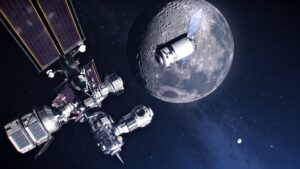SpaceX beat out proposals from Boeing, Northrop Grumman and Sierra Nevada Corporation for the indefinite-delivery, indefinite-quantity contract, with a maximum value of $7 billion over its 15-year life.
Since the announcement, neither NASA nor SpaceX have provided many updates on the contract or the development of the Dragon XL spacecraft that the company plans to use to carry out the cargo missions to the Gateway. Each Dragon XL, launching on a Falcon Heavy, is designed to transport at least five metric tons of pressurized and unpressurized cargo on the Gateway and also dispose of trash at the end of its mission.
One NASA official acknowledged at a recent meeting that, a year after awarding the contract, work on the contract has yet to begin. “We’ve selected SpaceX, and we’re still working on when we’re going to start that contract and all the different details, when we’re even going to be able to work with them on those types of things,” said Dina Contella, manager for mission integration and utilization in the Gateway program, during an April 9 meeting of a National Academies committee supporting the ongoing planetary science decadal survey.
She was responding to a question about the potential use of the Dragon XL cargo vehicle for hosting scientific payloads during or after its mission to the Gateway. SpaceX is interested in supporting such research, she said, but there’s been little discussion so far between NASA and SpaceX on how to do so. “We have yet to really kick off our discussions on that post-departure science with them, based on our contract status.”
NASA, in a statement provided to SpaceNews April 14, said it has yet to formally authorize SpaceX to proceed on the Gateway Logistics Services contract because the agency is studying the overall schedule of the Artemis lunar exploration program, of which development and use of the Gateway is just one part.
“An agency internal Artemis review team is currently assessing the timing of various Artemis capabilities, including Gateway. The goal of this internal review is to evaluate the current Artemis program budget and timeline, and develop high-level plans that include content, schedule, and budgets for the program,” the agency stated.
“The timing for the Gateway Logistics Services program’s authorization to proceed will be determined following conclusion of the review,” NASA added, but provided no schedule for completing the review.
A NASA procurement database shows that the agency has obligated a little more than $14 million on its Gateway Logistics Services contract with SpaceX. Most of that — $12.7 million — came from a pair of contract modifications in September 2020 to cover work on enhanced communications and “heavy ion environment testing” for operations in cislunar space. Those two contract modifications are the most recent actions on the contract.
Another contact modification earlier in September 2020, valued at about $680,000, was described in the database as “Requirement Change Evaluation for Gateway Logistics Services Risk Mitigation Due to delayed Authority to Proceed.”
It’s not clear when missions to the Gateway that require cargo delivered by SpaceX will begin. NASA now expects to launch the first two Gateway modules, the Power and Propulsion Element (PPE) and the Habitation and Logistics Outpost (HALO), on a SpaceX Falcon Heavy in 2024 under a contract awarded Feb. 9. Additional elements from international partners, including Canada, Europe and Japan, will follow.
The soonest astronauts would visit the Gateway would be the Artemis 3 mission, launching no earlier than 2024. However, Contella noted in her presentation that NASA was still studying the option of having the Orion spacecraft for Artemis 3 dock directly with the lunar lander, rather than have both Orion and the lander dock with the Gateway as planned for later Artemis missions.
Once crews start visiting the Gateway, Contella said she expected the need for one cargo resupply mission per crewed mission, which will carry supplies and equipment for the astronauts staying on the Gateway and potentially additional science payloads. “It will be able to provide quite a number of payloads. The main issue is just the amount of upmass required in general for the crewed missions,” she said. “There’s a lot of logistics required just for the mission itself.”
NASA is interested in using the lunar Gateway for science, with experiments both mounted on its exterior and inside the modules. That includes, Contella said, the possibility of using the Dragon XL spacecraft for experiments once it departs the Gateway at the end of its resupply mission. The spacecraft will not return to Earth but instead be disposed in a heliocentric orbit.
“We’re investigating the potential use of our Gateway logistics modules, the SpaceX vehicle, in providing payload support services after the logistics module has departed Gateway,” she said. “If it’s going to heliocentric space, then you can continue to study your science after it has departed.”
“That will cost money for operations,” she added, “but it might enable some significant science. We’ll have to work with our SpaceX vendor on that.”



